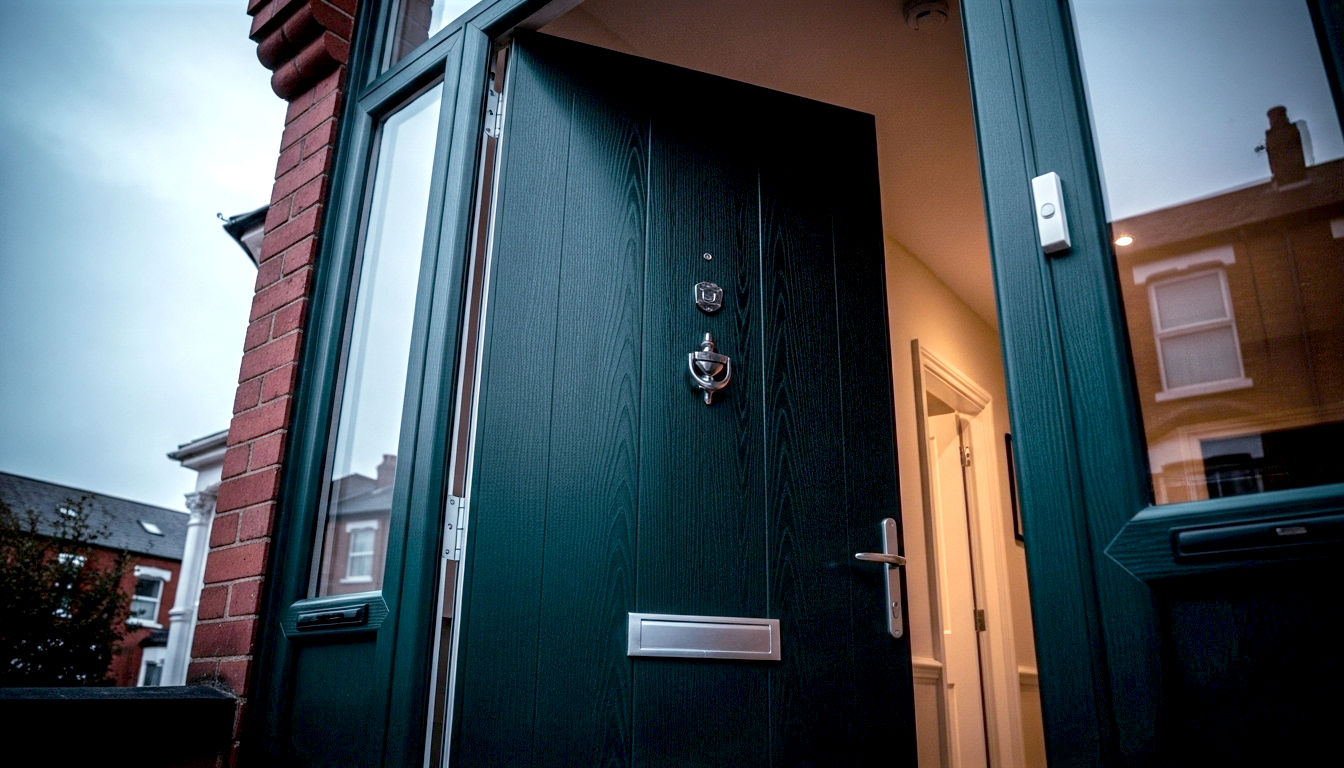Not Just a Pretty Face: The Guide to What a Composite Door is Really Made Of
Discover what a composite door is really made of. This definitive guide breaks down the high-tech materials—from the GRP skin to the insulating core—that make them the UK’s favourite front door.

This post may contain affiliate links. If you make a purchase through these links, we may earn a commission at no additional cost to you.
Walk down any British street, from the neat suburban closes of Surrey to the terraced rows of Manchester, and you’ll see them. They’re the handsome, sturdy-looking front doors that have quietly become the nation’s favourite. They might look like traditional timber, painted in a smart Farrow & Ball-esque shade of sage green or deep blue, but they don’t behave like wood. They don’t warp in our famously damp weather, their colour doesn’t fade after a few years of sun and rain, and they shut with a reassuringly solid thud.
These are composite doors, and they represent a quiet revolution in home improvement. For decades, the choice for your front door was simple: wood or uPVC. Wood was beautiful but a bit of a diva, demanding regular painting and prone to swelling and shrinking with the seasons. uPVC was practical and cheap but, let’s be honest, often lacked a bit of charm and could look tired and plasticky over time.
Then, the composite door came along and changed the game. It promised the best of both worlds: the classic, stylish look of timber with the low-maintenance, high-performance benefits of modern materials. But what exactly is this wonder-door? How can one door be so strong, so secure, and so good at keeping the heat in?
The secret is in the name. A composite door isn’t made from a single material but is engineered from a combination—or ‘composite’—of different materials, each chosen for a specific job. Think of it like a high-tech sandwich. Each layer has a purpose, and when they’re all bonded together under immense pressure, they create something far stronger, more durable, and more efficient than any single material could ever be on its own.
This guide will peel back those layers. We’re going to look inside a composite door to understand exactly what it’s made of, why those materials are used, and how they come together to create the ultimate front door for a British home. Whether you’re thinking of upgrading your own front door or you’re just curious, prepare to become an expert.
The Anatomy of a Modern Fortress: A Layer-by-Layer Breakdown
To truly understand a composite door, we need to dismantle it piece by piece. While designs vary slightly between manufacturers, almost all high-quality composite doors share the same fundamental structure: a robust outer frame, a super-strong skin, and a dense, insulating core.
1. The Core: The Heart of the Matter
The core is the thick, central part of the door that does the heavy lifting. It’s responsible for the door’s strength, stability, and, crucially for our energy bills, its thermal insulation. There are two main types of core used in the UK market today.
The High-Density Polyurethane Foam Core
This is the most common and popular choice, and for good reason. Imagine a very dense, solid version of the foam you find in a high-quality cool box. This isn’t flimsy, air-filled stuff; it’s a solid, closed-cell polyurethane foam that is injected into the door’s structure and bonds with the other layers as it sets.
- Simplified Explanation: Think of it as a super-strong, insulating filler that makes the whole door incredibly rigid and stops heat from passing through. It’s like filling a hollow chocolate Easter egg with solid caramel—it becomes much stronger and there are no empty spaces.
- Detailed Explanation: The technical term is CFC-free polyurethane foam. During manufacturing, this liquid foam is injected between the door skins and expands to fill every single nook and cranny. As it cures, it forms a powerful chemical bond with the internal frame and the skins, creating a single, solid slab or ‘monocoque’ structure. This process gives the door immense structural integrity. Its primary job, however, is insulation. The foam traps millions of tiny gas bubbles, which are very poor conductors of heat. This dramatically reduces thermal transfer, meaning it keeps your warm air in during the winter and the hot air out during the summer. This is measured by something called a U-value, where a lower number means better insulation. A modern composite door with a foam core can achieve U-values as low as 1.4 W/m²K or even better, easily meeting and exceeding UK building regulations.
The Solid Timber Core
For those who want the ultimate in strength and a more traditional feel, some premium composite doors are built around a solid timber core. This isn’t just one big lump of wood, which would be prone to warping. Instead, it’s an engineered core made from multiple layers of laminated veneer lumber (LVL).
- Simplified Explanation: Imagine stacking several thin sheets of wood on top of each other, with the grain of each sheet running in a different direction. When you glue and press them together, you get a block of wood that is incredibly strong and won’t twist or bend like a normal plank.
- Detailed Explanation: This multi-layered construction is key. Each layer of wood counteracts the natural tendency of the other layers to move, swell, or shrink with changes in temperature and humidity. This makes the core exceptionally stable. These cores are typically between 44mm and 48mm thick, making for a reassuringly heavy and robust door. The primary advantage of a solid timber core is its sheer strength and security. It offers outstanding resistance to physical attack. While the polyurethane foam core is incredibly insulating, a solid timber core also provides excellent thermal performance, thanks to the natural insulating properties of wood. It creates a door with a satisfying weight and a truly solid feel that many homeowners love.
2. The Skin: The Face of the Door
The ‘skin’ is the outer layer on both sides of the door. This is the part you see and touch, the part that has to look good while standing up to everything the British weather can throw at it. It needs to be tough, weatherproof, and fade-resistant. The material used here is almost universally Glass Reinforced Plastic (GRP), also known as fibreglass.
- Simplified Explanation: GRP is the same super-strong, lightweight, and waterproof material used to make boat hulls, fishing rods, and the bodywork of some sports cars. It’s tough as old boots but can be moulded to look exactly like painted wood.
- Detailed Explanation: GRP is a composite material in its own right. It consists of fine glass fibres embedded within a strong polymer resin. The manufacturing process allows this skin to be moulded with a highly realistic woodgrain texture, which is far more convincing than the flat, shiny surface of a uPVC door. This texture is created from a mould taken from a real timber door, capturing all the natural imperfections and patterns of the grain.
The colour isn’t just painted on top, either. For high-quality doors, the colour is part of the GRP skin itself, a process called ‘through-colouring’. This means if the door gets a deep scratch, it won’t reveal a white layer underneath; the colour runs all the way through. The skin is also finished with a protective coating that blocks UV rays, preventing the colour from fading in the sun, and repels water, stopping it from soaking into the door. This GRP skin is one of the main reasons composite doors are so incredibly low-maintenance. A simple wipe with a damp cloth is all it ever needs to look brand new.
3. The Frame and Sub-Frame: The Skeleton
Holding the core and skins together is an internal frame, or skeleton. This provides the door’s rigidity and is what the hinges and locking mechanisms are fixed to.
The outer door frame—the part fixed to your house—is typically made from steel-reinforced uPVC. This provides a strong, weatherproof, and low-maintenance surround that perfectly matches the modern performance of the door slab itself.
Inside the door slab, there’s a sub-frame. In doors with a polyurethane core, this is often a water-resistant composite material or engineered timber. Its job is to provide a solid structure around the foam and a secure fixing point for the hardware. In solid timber core doors, the laminated wood block forms the frame itself. A crucial component of this internal structure is the locking block. This is a particularly strong, often timber or LVL, section of the frame where the multi-point locking system is housed, ensuring that the locks are anchored into the strongest part of the door.
How It All Comes Together: The Manufacturing Process
Creating a composite door is a feat of modern engineering.
- Building the Skeleton: First, the internal sub-frame is constructed. This includes the strong LVL sections where the locks and hinges will be fitted.
- Moulding the Skins: The GRP skins are precision-moulded with the desired woodgrain effect and colour.
- The Sandwich Assembly: The front and back skins are placed in a large press. The internal frame is positioned between them.
- Injection and Bonding: If it’s a foam core door, the polyurethane foam is injected into the cavity. It expands and bonds everything together under high pressure and heat, creating a single, inseparable unit. For a solid timber core, the laminated core is bonded securely to the skins and frame.
- Curing and Finishing: The door slab is left to cure, creating an incredibly strong and stable panel.
- Glazing and Hardware: If the design includes glass, a sealed and insulated glazing cassette is expertly fitted. Finally, the high-security multi-point locks, handles, letterbox, and hinges are installed.
This meticulous process ensures that every component works in harmony, resulting in a door that is far greater than the sum of its parts.
So, Why Does This Matter? The Real-World Benefits for Your Home
Understanding what a composite door is made of is interesting, but the real question is: what does it all mean for you as a homeowner? Why have these doors become the go-to choice for so many people across the UK?
Unrivalled Security
Your front door is the first line of defence for your home. This is where the composite door’s construction truly shines.
- The solid core (whether foam or timber) and tough GRP skin make the door slab itself incredibly resistant to forced entry. It won’t be kicked in easily.
- The strong internal frame provides a rock-solid anchor for the locking mechanism.
- Modern composite doors are fitted with multi-point locking systems as standard. When you lift the handle and turn the key, several hooks and bolts engage simultaneously up and down the frame, clamping the door shut.
- The locks themselves are anti-snap, anti-drill, and anti-pick cylinders, designed to withstand common burglary techniques.
Most composite doors are tested to meet the PAS 24:2016 security standard, a rigorous test that simulates an attack by a burglar. Many also have Secured by Design accreditation, the official police security initiative. That combination of materials and hardware is what gives you real peace of mind.
Exceptional Thermal Efficiency
With energy prices being a constant worry for British households, keeping heat inside your home has never been more important. Traditional wooden doors can be draughty, and older uPVC doors don’t offer great insulation.
The high-density polyurethane foam core is a superb insulator. It drastically reduces heat loss, helping to keep your home warmer in winter and lowering your heating bills. The insulated glazing units used in composite doors also play a vital part. Combined with the weatherproof seals around the frame, a composite door creates an airtight barrier against the cold. This focus on thermal performance helps modern homes become more energy-efficient and environmentally friendly.
Incredible Durability and Low Maintenance
Life in Britain means dealing with a lot of rain, wind, and the occasional blast of summer sun. Materials left outside need to be tough.
- The GRP skin is waterproof and weather-resistant. Unlike timber, it won’t rot, warp, or twist when it gets wet.
- The through-colour technology means the colour won’t chip, flake, or peel. You can throw away your paintbrush because a composite door will never need repainting.
- The whole structure is incredibly stable and robust, so it will continue to open and close smoothly for years to come without sticking in the frame.
The appeal is simple: once it’s installed, you can pretty much forget about it. A quick wipe-down now and then is all the maintenance it needs to look its best, leaving you with more time to spend on things you actually enjoy.
Stunning Kerb Appeal
For all their practical benefits, composite doors have also won our hearts because they look fantastic. They offer the timeless, classic aesthetic of a wooden door without any of the drawbacks.
- Authentic Woodgrain Finish: The moulded GRP skin provides a deep, convincing woodgrain effect that looks and feels like the real thing.
- A World of Colour and Style: You can choose from a vast range of colours, from classic black and white to contemporary greys and bold reds. There are hundreds of styles available, from traditional Victorian and Edwardian designs to sleek, modern options with minimalist hardware.
- Glazing Options: You can personalise your door with a wide array of decorative glass panels, including frosted, patterned, or leaded designs, allowing light to flood into your hallway while maintaining privacy.
A new composite door is one of the quickest and most effective ways to give your home a facelift, boosting its kerb appeal and making a great first impression.
The Verdict: A Modern Classic Built to Last
So, what is a composite door made of? It’s made of clever ideas and advanced engineering. It’s a fusion of materials, each one playing a critical role. It has a heart of solid, insulating foam or powerfully engineered timber, a skeleton of resilient composite, and a tough, weatherproof skin of GRP that can be styled to look just like a beautiful traditional door.
It’s a door designed for the realities of modern British life. It’s secure enough to protect our families, efficient enough to save us money on our energy bills, and durable enough to stand up to our weather without demanding our constant attention. It’s a perfect example of how innovative materials can be used to create a product that is practical, beautiful, and built to last a lifetime. The next time you close one and hear that satisfying clunk, you’ll know exactly what’s inside: a masterpiece of composite engineering.
Further Reading
For those interested in diving deeper into the standards and specifics of doors in the UK, here are some highly respected resources:
- Secured by Design: The official police security initiative that works to improve the security of buildings and their immediate surroundings to provide safe places to live, work, shop, and visit. https://www.securedbydesign.com/
- The Glass and Glazing Federation (GGF): The primary trade association for the flat glass, glazing, and fenestration industry in the UK. A great source for consumer advice. https://www.ggf.org.uk/
- FENSA: The government-authorised scheme that monitors building regulation compliance for replacement windows and doors in England and Wales. https://www.fensa.org.uk/
- Energy Saving Trust: An independent organisation working to address the climate emergency, providing expert insight and advice on home energy efficiency. https://energysavingtrust.org.uk/






